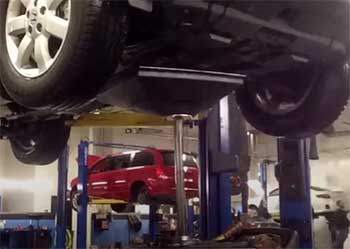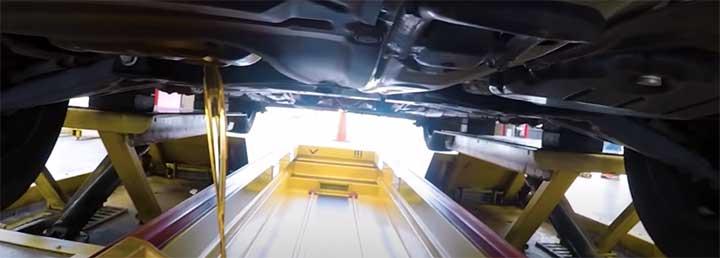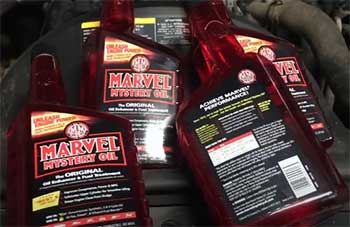Getting your oil changed regularly is one of the most important things you can do to keep your car running smoothly for years to come. But where should you go to get that oil change done?
The dealership where you bought the car or a quick-lube shop like Valvoline? In this comprehensive guide, we’ll compare the pros and cons of dealership oil changes versus Valvoline oil changes to help you decide which is best for your needs.
A Brief Comparison Table
| Factor | Dealership | Valvoline |
| Cost | $$$ (60+ for conventional) | $ (40 or less for conventional) |
| Convenience | Varies by location | Open evenings & weekends, 1,500+ locations |
| Tech Expertise | Factory-trained for your model | ASE-certified general automotive |
| Parts Used | Genuine OEM | Aftermarket |
| Extra Inspections | Yes | No |
| Interval Upselling | Common | Less frequent |
| Brand Trust | Higher for some | Varies by location |
| Speed of Service | Varies greatly | Under 30 minutes, no appointment |
| Environmental Practices | Varies | Recycled oil, oil re-refining |
Oil Change Basics

Before diving into the details of dealerships versus Valvoline, let’s do a quick overview of why regular oil changes are so crucial in the first place.
Your car’s engine oil has two main jobs: lubricating the engine to prevent wear and tear, and keeping things cool by carrying heat away from the engine.
As you drive your car, the oil gets contaminated by dirt, metal particles created by engine friction, fuel residues, and more.
This contamination degrades the oil’s lubricating properties and prevents it from cooling the engine effectively.
That’s where oil changes come in. By draining out all the old, dirty oil and replacing it with fresh new oil, you get rid of those contaminants and restore the oil’s ability to properly lubricate and cool.
Most automakers recommend getting your oil changed every 5,000-7,500 miles or about every 6 months to 1 year, whichever comes first.
Signs that it’s time for an oil change include:
- The “check engine” or “oil change required” light comes on
- Dark, murky oil on the dipstick
- Low oil level on the dipstick
- Increased engine noise when accelerating
- Oil leaks under the car
- Burning odor from the engine bay
Now let’s look at the key differences between getting your oil changed at the dealership or a Valvoline location.
Oil Changes at the Dealership
Taking your car to the dealership for an oil change comes with some notable advantages:
- Familiarity with Your Vehicle
Dealership technicians work on your particular make and model every day. They know exactly what type of oil and oil filter your car needs without having to look it up. You can be confident they’ll use the right products for your vehicle.
- OEM Parts
Dealerships use 100% genuine OEM (original equipment manufacturer) parts like oil filters and drain plug washers. These parts come from the company that made your car, so you know they’ll fit and function properly.
- Extra Inspections
A dealership oil change often includes free inspections of your vehicle’s fluids, belts, hoses, tires, brakes, battery, and more. This comprehensive check can spot minor issues before they turn into major repairs.
- Factory-Trained Techs
Technicians at dealerships undergo extensive training on your specific make and model. Their expertise gives added peace of mind that all steps of the oil change will be done correctly.
- Convenience
If you already take your car to the dealership for routine maintenance or repairs, getting the oil changed there too is very convenient. No need to make a separate trip to another facility.
- OEM Warranties
Sticking with OEM parts helps maintain validity of the factory powertrain warranty. Non-OEM parts can potentially void warranties.
- Brand Trust
For many people, sticking with the brand dealership provides a sense of trust and assurance versus third-party shops.
Potential Downsides to Dealership Oil Changes
Dealership oil changes also come with a few drawbacks to be aware of:

- Cost
Oil changes at brand dealerships are often more expensive than independent shops, sometimes significantly so.
The difference can be $20-40 for a basic oil change.
- Interval Upselling
Some dealerships are aggressive about trying to sell you on short 3,000 mile oil change intervals, even if your car doesn’t need changes that often.
This costs you more money over time.
- Unneeded Services
Additionally, dealers may recommend extra services like fuel injections cleanings or flushings that your car doesn’t really require yet.
- Branding Upcharging
You pay a premium price at dealers for OEM parts and branding, versus the exact same generic version of the parts.
- Inconsistent Quality
Dealership oil change practices, wait times, and customer service can vary widely depending on the specific location.
Also Read: Reasons For Volvo Oil Changes Being So Expensive.
Oil Changes At Valvoline

Now let’s examine the key pros and cons of choosing a national quick-lube chain like Valvoline for your oil changes instead:
- Convenience
With over 1,500 locations nationwide, Valvoline shops are everywhere for incredible convenience. Getting in and out is fast, with no appointment needed. Most locations have evening and weekend hours too.
- Low Prices
Valvoline oil changes are generally much cheaper than dealerships. For a basic conventional oil change, expect to pay $40 or less at Valvoline versus $60 or more at a dealership.
- Coupons and Deals
There are always coupons and promotional specials available to save even more money at Valvoline. Multi-vehicle and rewards programs also help lower costs.
- No Pressure Services
Valvoline technicians won’t try to upsell you on shorter intervals or unnecessary add-ons. You get just the basic oil change you came for.
- ASE-Certified Techs
While not factory-trained on your specific model, techs at Valvoline are certified by the ASE (Automotive Service Excellence). So they still have solid automotive expertise.
- Fast Service
Valvoline shops are set up for maximum efficiency. Most locations don’t take appointments so you’ll be in and out in 30 minutes or less.
- Environmental Practices
Valvoline uses recycled oil and re-refines used oil themselves. This supports sustainability and reduces environmental impact.
However, Valvoline oil changes also have some downsides to consider:
- Less Familiar with Your Car
With all makes and models coming through, Valvoline techs don’t have specialized expertise in your particular vehicle. More risk of an improper oil type being used.
- Aftermarket Parts
Valvoline primarily uses aftermarket parts for things like oil filters and drain plug washers. These are cheaper than OEM but may fit less precisely.
- Upselling of Extras
While less pushy than dealers on oil change intervals, Valvoline techs are still trained to upsell you on extra services like air filters, which may not be needed when they recommend.
- More Consistency Issues
With over 1,500 independently operated shops, there is greater variability in Valvoline location quality from spotty to outstanding.
- No Extra Inspections
A basic Valvoline oil change does not include free inspections of other vehicle systems like a dealership does. Issues can go unnoticed longer.
- No Factory Warranty Benefit
Using aftermarket parts won’t directly void your warranty but also provides no added warranty advantages like OEM parts.
Also Read: Comparison of Walmart And Take 5 Oil Change.
Frequently Asked Questions (FAQ)
Yes, Valvoline is a top-rated motor oil brand that meets leading industry certifications. Their conventional, synthetic blend, full synthetic, and high mileage oils are all good options for any vehicle.
For a basic oil change with 5 quarts of conventional oil, expect to pay $40-75 depending on the shop. Paying over $100 likely means upsells on extras not needed.
Valvoline follows the standard 5,000-7,500 mile recommendation. Check your owner’s manual as some automakers call for more frequent changes.
With full synthetic oil, Valvoline says you can go 7,500-20,000 miles or up to 12 months between changes. Adjust based on your driving conditions and automaker recommendations.
Closing Remarks
As you can see, both dealership and Valvoline oil changes have their advantages and disadvantages. Key factors to consider are your budget, convenience needs, brand loyalty, driving habits, and factory maintenance recommendations for your particular vehicle.
Many people alternate between the two options – getting dealership oil changes halfway through the warranty period to maintain coverage, and otherwise using Valvoline for affordability. But always follow the manufacturer guidelines for your specific car above all else.
Proper oil change intervals and using quality oil keeps your engine running well for the long haul.

